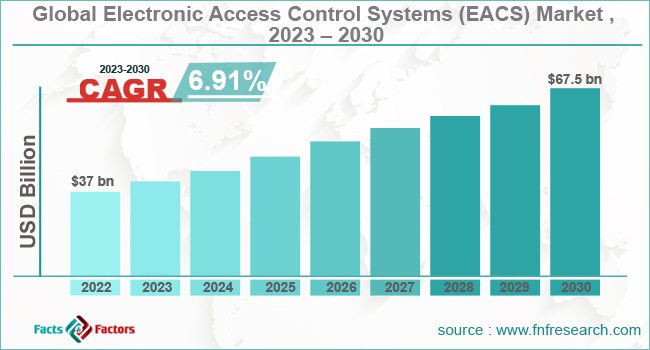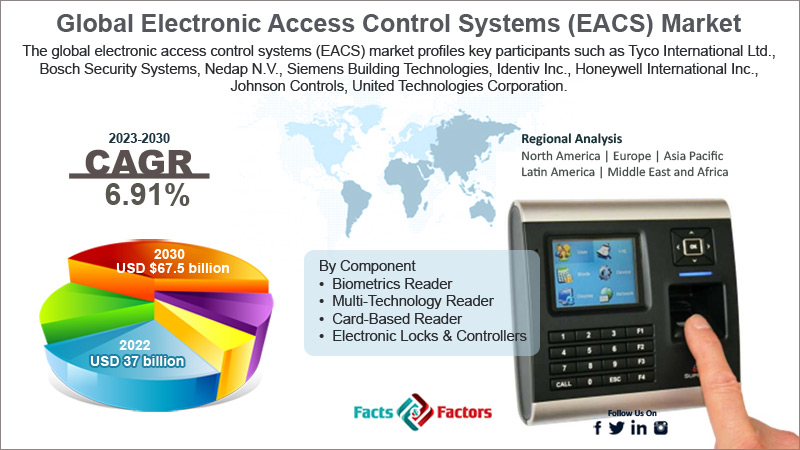Search Market Research Report
Electronic Access Control Systems (EACS) Market Size, Share Global Analysis Report, 2023 – 2030

Electronic Access Control Systems (EACS) Market Size, Share, Growth Analysis Report By Component (Biometrics Reader, Multi-Technology Reader, Card-Based Reader, and Electronic Locks & Controllers), By Vertical (Commercial Spaces, Government, Education, Military & Defense, Residential, Healthcare, and Industrial), and By Region - Global and Regional Industry Insights, Overview, Comprehensive Analysis, Trends, Statistical Research, Market Intelligence, Historical Data and Forecast 2023 – 2030
Industry Insights
[213+ Page Report] According to the report published by Facts & Factors, the global electronic access control systems (EACS) market size was evaluated at $37 billion in 2022 and is slated to hit $67.5 billion by the end of 2030 with a CAGR of nearly 6.91% between 2023 and 2030. The market report is an indispensable guide on growth factors, challenges, restraints, and opportunities in the global marketspace. The electronic access control systems industry report covers the geographical market along with a comprehensive competitive landscape analysis. It also includes cash flow analysis, profit ratio analysis, market basket analysis, market attractiveness analysis, PESTEL analysis, SWOT analysis, Porter’s five force analysis, and value chain analysis. Additionally, the electronic access control systems market report explores the investor and stakeholder space to help companies make data-driven decisions.

 Market Overview
Market Overview
Electronic Access Control Systems (EACS) is a component of a completely integrated facility management system. Furthermore, the electronic access control system is interfaced with fire life safety tools, video surveillance systems, HVAC systems, and communication systems. Reportedly, electronic access control systems make utilization of door lock to control access tools, computer, and credential reader. Moreover, these systems provide as well as deny virtual as well as physical access to virtual or physical space. In addition to this, EACS offers technology for people, vehicles, and traffic. There are various kinds of EACs such as rule-based, discretionary, role-based, and mandatory.
 Key Insights
Key Insights
- As per the analysis shared by our research analyst, the global electronic access control systems (EACS) market is projected to expand annually at the annual growth rate of around 6.91% over the forecast timespan (2023-2030)
- In terms of revenue, the global electronic access control systems (EACS) market size was evaluated at nearly $37 billion in 2022 and is expected to reach $6.9167.5 billion by 2030.
- The global electronic access control systems market is anticipated to record massive growth over the forecast period owing to electronic access control systems find a slew of applications in commercial and defense sectors.
- Based on the component, the biometrics reader segment is predicted to contribute majorly toward the global market share over the forecast timeline.
- In terms of vertical, the residential segment is projected to dominate the global market size over 2023-2030.
- Region-wise, the North American electronic access control systems (EACS) market is projected to register the fastest CAGR during the assessment period.

 Industry Growth Factors
Industry Growth Factors
- Rise in cyber-attacks & cyber-terrorism to upswing the growth of the global market in the next few years
Growing terrorist attacks and trespassing have led to the need for improved security systems, thereby translating into escalating growth of the global electronic access control systems (EACS) market. Furthermore, electronic access control systems find a slew of applications in commercial and defense sectors. Rapid growth in the banking, retail, IT, and hospital sectors will proliferate the expansion of the electronic access control systems (EACS) market. With the thriving authentication systems industry projected to expand at a rapid pace due to growing security concerns, the global market is set to expand by leaps & bounds in the coming years.
Furthermore, rise in the cases of vandalism, violence occurring in public places, and acts of terrorism in urban regions will steer the expansion of the electronic access control systems (EACS) market across the globe. In addition to this, the surge in demand for EACS in various educational institutes will spur global market trends.
 Restraints
Restraints
- High installation costs to put brakes on the global industry over 2023-2030
A low level of awareness about benefits accrued by electronic access control systems and costly upfront spending can halt the growth of the global electronic access control systems (EACS) industry. Apart from this, huge deployment costs witnessed in emerging economies can pose a threat to the expansion of the industry across the globe.
 Opportunities
Opportunities
- Demand for robust security & surveillance to open new growth opportunities for the global market
The need for strong firewalls to counter cases of data theft has opened new opportunities for growth for the global electronic access control systems (EACS) market. Rising housing standards and the launching of smart city projects globally will create new vistas of expansion for the global market.
 Challenges
Challenges
- Demand for secured systems for safeguarding residential & commercial spaces put a huge challenge in the growth path of the global industry
No technological system is fault-tolerant and this is a major challenge for the product manufacturers. Moreover, the need for safer systems to prevent intrusion in residential and commercial sectors has put a big challenge for the global electronic access control systems (EACS) industry.
 Segmentation Analysis
Segmentation Analysis
The global electronic access control systems (EACS) market is sectored into component, vertical, and region.
In terms of component, the global electronic access control systems market is sectored into biometrics readers, multi-technology readers, card-based readers, and electronic locks & controllers segments. Furthermore, the biometrics reader segment, which contributed to the largest share of the global market in 2022, is projected to establish its segmental dominance in the forecast timespan. The segmental growth in the coming eight years can be subject to the humungous use of biometrics readers for iris scans, facial recognition, and fingerprints. The surge in smart home acceptance and rising awareness about safety as well as surveillance will embellish the demand for biometrics readers.
Based on vertical, the electronic access control systems industry across the globe is divided into commercial spaces, healthcare, government, education, residential, military & defense, and industrial segments. Moreover, the residential segment, which garnered nearly half of the global industry share in 2022, is projected to lead the global industry growth even in the forecasting timespan. The growth of the segment in the ensuing years can be due to a rise in investments in smart home technologies and smart equipment in the residential sector.
 Recent Breakthroughs:
Recent Breakthroughs:
- In the first half of 2022, TrustSEC, a leading firm in the information security domain focusing on creating secured hardware & software solutions, launched the TrustSEC Bio Access control card. The strategic move is likely to expedite the expansion of the electronic access control systems (EACS) market across the globe.
- In October 2022, SALTO Systems, a firm coining processes for replacing mechanical keys with digital & smart keys, launched its first new immersive XSperience center in Melbourne, Australia. The new center demonstrates new smart electronic access control providing an extensive range of electronic locks & lockers along with on-premise & cloud software solutions. The initiative will boost the growth of the electronic access control systems (EACS) industry in Australia.
- In the third quarter of 2021, Fingerprint Cards AB, a global leading biometric firm, introduced the first biometric solution for the personal computer industry. The move will boost the growth of electronic access control systems (EACS) business globally.
 Report Scope
Report Scope
Report Attribute |
Details |
Market Size in 2022 |
USD 37 Billion |
Projected Market Size in 2030 |
USD 67.5 Billion |
CAGR Growth Rate |
6.91% CAGR |
Base Year |
2022 |
Forecast Years |
2023-2030 |
Key Market Players |
Tyco International Ltd., Bosch Security Systems, Nedap N.V., Siemens Building Technologies, Identiv Inc., Honeywell International Inc., Johnson Controls, United Technologies Corporation., Schneider Electric, Dormakaba Holding, Assa Abloy AB, Magal Security Systems Ltd, NEC Corporation, Future Fibre Technology, Cisco Systems Inc., Godrej Consumer Product Limited., Hitachi Ltd., Allegion plc, Suprema HQ., and others. |
Key Segment |
By Component, Vertical, and Region |
Major Regions Covered |
North America, Europe, Asia Pacific, Latin America, and the Middle East &, Africa |
Purchase Options |
Request customized purchase options to meet your research needs. Explore purchase options |
 Regional Insights
Regional Insights
- Asia-Pacific Electronic Access Control Systems (EACS) market to accrue massive revenues over the forecast timeline
The Asia-Pacific, which accounted lucratively towards the global electronic access control systems (EACS) market revenue in 2022, is anticipated to continue its dominance over the analysis timeframe. The regional market expansion over 2023-2030 can be owing to the growing focus on security & surveillance in commercial & government sectors in countries such as India, Malaysia, Philippines, China, Japan, Singapore, and Taiwan. The rise in demand for secured access control solutions will drive regional market trends.
Furthermore, the North American electronic access control systems (EACS) industry, which recorded lucrative growth in 2022, is set to register the fastest CAGR over the forecast timespan. The growth of the regional market can be attributed to the U.S. being the major supplier of electronic access control systems to other emerging economies. The growing need for high-level security in public and commercial spaces will further expedite the expansion of the industry in North America in the upcoming years.
 Competitive Space
Competitive Space
- Tyco International Ltd.
- Bosch Security Systems
- Nedap N.V.
- Siemens Building Technologies
- Identiv Inc.
- Honeywell International Inc.
- Johnson Controls
- United Technologies Corporation.
- Schneider Electric
- Dormakaba Holding
- Assa Abloy AB
- Magal Security Systems Ltd
- NEC Corporation
- Future Fibre Technology
- Cisco Systems Inc.
- Godrej Consumer Product Limited.
- Hitachi Ltd.
- Allegion plc
- Suprema HQ.
The global electronic access control systems (EACS) market is segmented as follows:
 By Component
By Component
- Biometrics Reader
- Multi-Technology Reader
- Card-Based Reader
- Electronic Locks & Controllers
 By Vertical
By Vertical
- Commercial Spaces
- Government
- Education
- Military & Defense
- Residential
- Healthcare
- Industrial
 By Region
By Region
- North America
- The U.S.
- Canada
- Mexico
- Europe
- France
- The UK
- Spain
- Germany
- Italy
- Rest of Europe
- Asia Pacific
- China
- Japan
- India
- Australia
- Southeast Asia
- Rest of Asia Pacific
- The Middle East & Africa
- Saudi Arabia
- UAE
- Egypt
- Kuwait
- South Africa
- Rest of the Middle East & Africa
- Latin America
- Brazil
- Argentina
- Rest of Latin America
Industry Major Market Players
- Tyco International Ltd.
- Bosch Security Systems
- Nedap N.V.
- Siemens Building Technologies
- Identiv Inc.
- Honeywell International Inc.
- Johnson Controls
- United Technologies Corporation.
- Schneider Electric
- Dormakaba Holding
- Assa Abloy AB
- Magal Security Systems Ltd
- NEC Corporation
- Future Fibre Technology
- Cisco Systems Inc.
- Godrej Consumer Product Limited.
- Hitachi Ltd.
- Allegion plc
- Suprema HQ.
Frequently Asked Questions

Copyright © 2025 - 2026, All Rights Reserved, Facts and Factors


